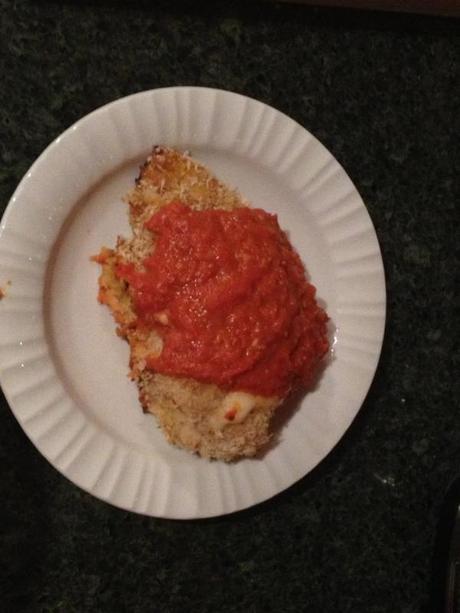
Mozzarella-Stuffed Honey-Mustard-Panko Chicken (c) KC Saling, 2013
Anyone who has tried to make a recipe off of the internet, out of a magazine, or from Pinterest, has learned a few choice things about life. Not just that braising is a dozen times more difficult that it seems, that there really is a difference in the results when you use salted or unsalted butter, and that nothing feels like a better accomplishment than finally, finally getting those meringue peaks to stand up stiffly after whipping until you feel like your arm is going to fall off. Those are all good things. No, I’m talking about the things you learn about life.
Cooking – or attempting to cook – someone else’s recipes teaches you a lot about life. I want to take a moment here and share with you some of the things I’ve learned, which I not-so-delicately call:
5 Things I Learned About Life from F&*#ing Up Recipes
1. Instructions not included.
If you’ve ever worked with anyone who’s really good at what they do, you’ll know that they skim over a lot in the instructions. Whether it’s a professor of mathematics who just assumes you know how to do integration by parts or a master chef who assumes you know the fundamentals of braising, they don’t always go into the details of what you actually need to do in order to make their wonderful creation.
I’m ready for this. I grew up cooking with a wonderful chef who just forgot to tell me until it was time to put the heavy cream into the stew that I needed to have that. And French cognac. And half a dozen other things that a gourmet chef keeps in his kitchen but I probably would have to wait three weeks to import into mine.
Sometimes people don’t tell you everything. Sometimes they forget. Sometimes they consider it a “trade secret.” But just assume that when you go to cook that recipe, you don’t have all the required parts and instructions for assembly. I do a lot of research prior to cooking, wandering into an assessment project, starting on a home improvement project, or going on a trip to a place I’ve never been before just because no matter who you talk to, no matter how great the source, one source is never enough to figure out everything you need to know.
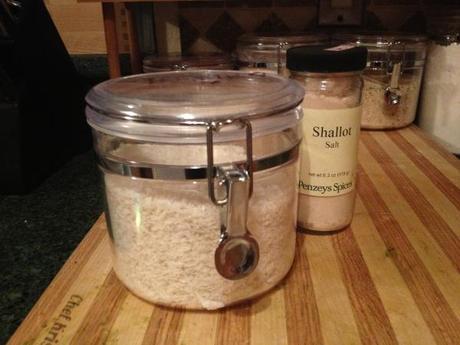
Ingredients (c) KC Saling, 2013
2. There is such a thing as a free lunch, but sometimes you get what you pay for.
There are literally tons of websites out there offering freebies, especially when it comes to recipes. You have the big cooking networks out there, Martha Stewart in all her glory, even the MasterChef gurus, offering you golden nuggets of knowledge in your quest to make an awe-inspiring appetizer or a kickass entree. You also have just about everyone with access to the Internet capable of sharing their food, from pictures of their food on Instagram and FoodSpotting to recipes on blogs, crowd-sourced food sites, and Tastebook.
I’m not a snob by any means. I make recipes from a zillion different sources, from my coveted Culinary Institute of America textbook {gifted – I didn’t go but wish I had!} to things I find on Pinterest. I’m not a professional chef. All I’ve done is cook along with one for a good portion of my life and take classes at a teeny culinary school, and there’s more to it than learning recipes. There’s food safety and rules of preparation, what to mix and how long to let it sit out, and a lot of other details the average person sharing their grandma’s favorite recipe might not know.
All I can say with all of these is: caveat emptor. Let the buyer beware. If you’re looking for a free recipe, or a free anything, consider the source.
3. Pin responsibly.
Let me refer you to this old post on pinning responsibly. A responsible Pinterest user checks the source before sharing something all over the interwebs. Not only might you be sharing a spam link or a bad link, you might be sharing something that, while it has a pretty picture attached to it, is just not a quality recipe.
So before you pin that too-good-to-be-true three ingredient no bake cookie recipe, check the source. Is it something that really is going to benefit us to share? Or are you going to lead someone into giving themselves a case of salmonella? Or are you giving free press and publicity to a lousy site that has one pretty picture on it?
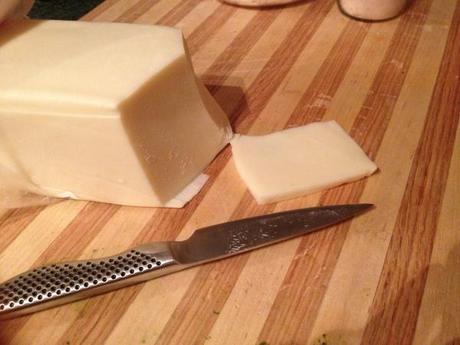
Mozzarella (c) KC Saling, 2013
4. Sometimes the simple things are best.
Downsizing, budgeting, trying to live frugally to pay off debt, and my cooking lately have taught me this. Sometimes things with a lot of embellishment are fun, but sometimes, in that process, you lose what really makes the thing of value. Sometimes you need all that fancy cream sauce, that garnish, that special plating, to make a really amazing meal…but sometimes, like with a humble scallop, all you need is salt and pepper and about 90 seconds of sear on each side. The rest just gets in the way of really appreciating it.
The same is true of traveling. When I travel and try to pack too much into a trip, all the details, all the sights and sounds and smells and experiences that make it a truly delicious experience, end up getting lost in the shuffle. There are some places, like Waikiki and the Bahamas, where the pace of life lets you go and pack in scuba diving, fine dining, and beachfront partying all in one day. And then there are places like the North Shore and Kauai where you’re doing yourself a genuine disservice if you don’t just sit there for a bit and be.
So don’t get seduced by those come-ons promised you by fancy spices, exotic sauces, and ingredients you can’t pronounce or find in your local store. They have their place, but that place isn’t always your kitchen.
5. Practice doesn’t make perfect, but if you’re smart, you learn from your mistakes.
I’ve learned a lot from just taking an idea and playing with it until I’ve got something that I actually like. It might not be what I originally intended to do or make, or be anything resembling it, but it’s something good. Then I keep tweaking it until it becomes something great. During this process, I do my best to keep track of the fixes I’ve made so that I can keep progressing and improving.
Every single one of my cookbooks is full of notes, substitutions, and annotations. Before any of my cookbook-writers out there get offended, it’s not because you don’t know your stuff, it’s not because I think I can make better recipes, and it’s not because I am obsessed with changing everything I touch. Okay, well, maybe I’m guilty of the last one. But not all the instructions are included {see Lesson 1} and sometimes you download a dud {see Lesson 2} and sometimes there’s a lot of extra stuff in there that you can eliminate for a meal that isn’t quite as decadently awesome as the original, but is pretty damn tasty in its own right {see Lesson 4}.
Like this one.
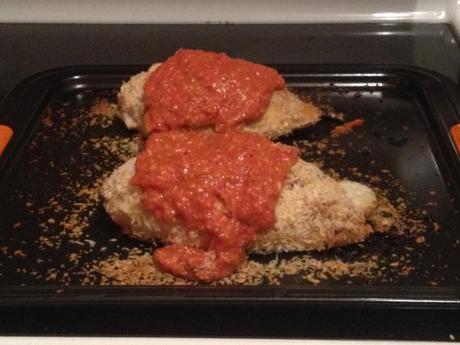
Mozzarella-Stuffed Honey-Mustard-Panko Chicken (c) KC Saling, 2013
Mozzarella Stuffed Honey-Mustard Panko Chicken
Makes 2 servings.
What you’ll need:
- 2 boneless skinless chicken breasts
- 4 slices fresh mozzarella
- 1/2 cup honey dijon mustard
- 1 cup panko
- 2 tsp shallot salt or other salt
- 2 tsp black pepper
- 1/2 cup tomato sauce
How to make it:
1. Preheat your oven to 375F. Wash the chicken, and pat it dry with a paper towel. You don’t want to get chicken juice everywhere. And if you do drip juice, get out your kitchen-friendly cleaner and deal with it post haste!
2. Slice the mozzarella you want to use, and then slice the chicken. That way, if you’re using the same knife, you won’t risk getting chicken on the cheese, which will pretty much make it unusable {hello, germs}. Lay the mozzarella down the slice you made in the chicken breast like so:

Slicing Chicken (c) KC Saling, 2013
Then fold the chicken around the cheese.
And yes, I really do worry about the possibility of contracting food-borne illness from raw chicken. That’s why there’s plastic wrap protecting my cutting board.
3. Pour the mustard into one small bowl and the panko into another. Mix the salt and pepper into the panko. Then dredge the chicken first through the mustard and then through the panko until it has a nice crispy coating.
4. Place it onto a lightly oiled baking sheet and place it in the oven. Let it cook for about 30 minutes.
5. Pull the chicken out and give it a nice covering of tomato sauce. I actually used the tomato sauce recipe I made to go with my polenta fries, and that turned out to be delicious. But you can use a regular tomato garlic or marinara sauce.
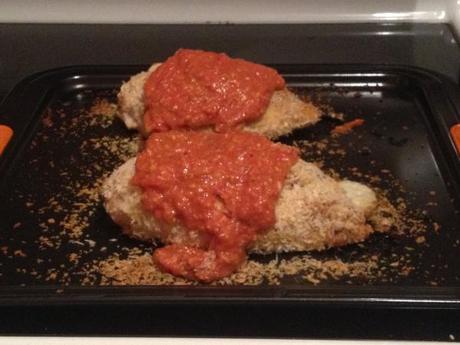
Mozzarella-Stuffed Honey-Mustard-Panko Chicken (c) KC Saling, 2013
6. Bake the chicken for another 5-7 minutes, until the tomato sauce is heated through.
7. Pull out the chicken. It doesn’t hurt to do a test cut to make sure it’s done. If you have a meat thermometer, it should read at least 170F. If you don’t, just make sure the center isn’t pink – that’s what the test cut is for.
8. Serve and enjoy! I like to serve mine along with a tasty salad, like this one:
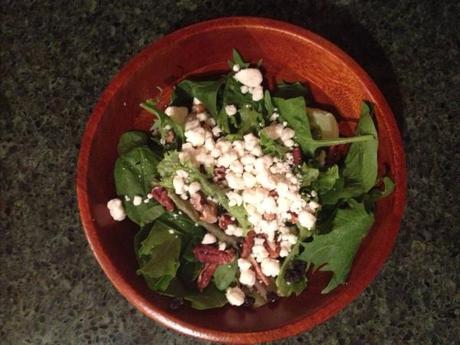
Feta Salad (c) KC Saling, 2013
It’s a combination of mixed greens, dried currants, pecan halves, and feta cheese, drizzled with my homemade vinaigrette. And just for a bonus, I’ll tell you how to make that.
You just need these things:
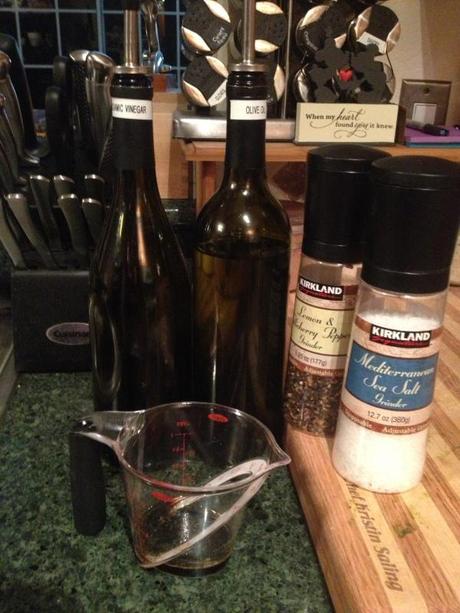
Making Vinaigrette (c) KC Saling, 2013
You need two parts olive oil, one part basaltic, and a dash of salt and pepper to taste. Mix it all up together and drizzle it over the salad. A buddy of mine used to make this by pouring the ingredients into a cleaned-out salsa jar and shaking it up. It works in a pinch if you’re looking for a light, simple dressing.
So now you’ve got all my secrets! Share some of yours! What are some of the best things you’ve learned from experimenting with recipes you found in a book or online? What has cooking taught you about life?
